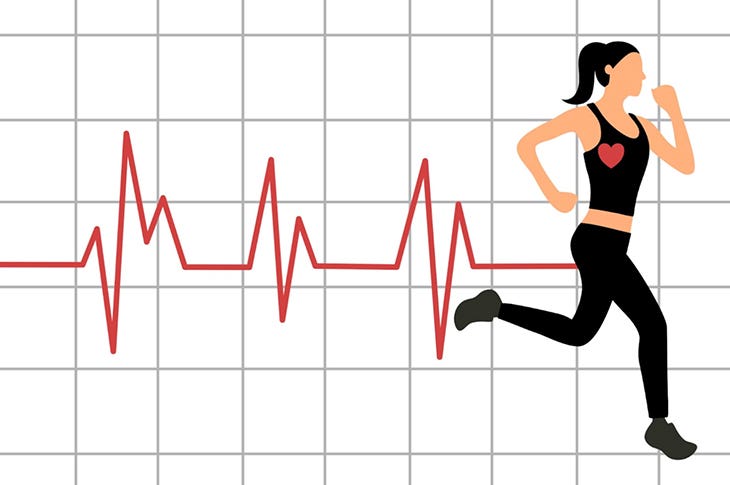This one activity can help reduce your risk of heart arrhythmia and stroke
The unique ‘Bruce protocol,’ a treadmill-based assessment that ups its intensity every three minutes, became the backbone of this research.

[Oct. 5, 2023: Staff Writer, The Brighter Side of News]
Taking a more spirited approach and walking briskly — defined as more than 40 steps per minute — brings even better results, dropping dementia risk by 57%. (CREDIT: Creative Commons)
Amidst the bustling crowd of medical professionals and journalists at the European Society of Cardiology conference, an impactful preliminary study surfaced, putting the spotlight on the significance of physical fitness in warding off major cardiovascular threats like atrial fibrillation (AFib) and stroke.
Taiwan's National Yang Ming Chiao Tung University's Department of Medicine Associate Professor Shih-Hsien Sung, MD, PhD, one of the pivotal figures behind this groundbreaking research, emphasized the robustness of their findings.
He stated, "This was a large study with an objective measurement of fitness and more than 11 years of follow up. The findings indicate that keeping fit may help prevent atrial fibrillation and stroke."
Starting with a massive pool of 15,450 AFib-free participants, researchers meticulously documented their fitness journeys. The unique 'Bruce protocol,' a treadmill-based assessment that ups its intensity every three minutes, became the backbone of this research.
Related Stories
The study wasn't just about how fast or how long participants could run. Instead, it was gauged using METs—metabolic equivalents. To simplify, think of METs as a lens viewing the intensity of physical activities concerning a set baseline.
As the years rolled on, some participants, about 3.3%, unfortunately developed AFib. But here's where it gets fascinating. With every MET jump during their treadmill assessments, participants witnessed an 8% plummet in Afib vulnerability, a heartening 12% descent in stroke risk, and a commendable 14% reduction in the threat of major adverse cardiovascular events.
Diving deeper into the MET scores, participants got grouped into three distinctive fitness brackets: Low, medium, and high. Those resting at the pinnacle, the high fitness bracket, could boast a whopping 98.4% probability of remaining Afib-free over half a decade.
A heart arrhythmia (uh-RITH-me-uh) is an irregular heartbeat. Heart rhythm problems (heart arrhythmias) occur when the electrical signals that coordinate the heart's beats don't work properly. (CREDIT: Mayo Clinic)
Understanding AFib: A Silent Global Menace
The Cleveland Clinic paints a clear picture of Afib. At its core, it's an erratic heart rhythm that finds its roots in the heart's upper chambers, the atria. This results in the heart's standard electrical impulses getting thrown into disarray, causing irregular heart rhythms and inefficient blood circulation from the atria to the lower chambers, known as ventricles.
With the daunting figure of 40 million diagnosed cases globally, AFib isn't just any disorder. It stands tall as the most widespread heart rhythm anomaly. European statistics around this are particularly alarming. One out of every three Europeans is foreseen to tangle with this disorder during their lifetime.
Professor Shih-Hsien Sung, MD, PhD. (CREDIT: National Yang Ming Chiao Tung University)
The stakes with Afib are high. Those diagnosed see their stroke risks magnifying by five times compared to AFib-free individuals. When we comprehend the weight these numbers carry, the global urgency to not just understand but actively prevent AFib becomes palpable.
A twist in the AFib tale is its often silent progression. Symptom manifestation largely depends on the ventricular beats' tempo. A normal or slightly rapid rhythm may fly under the radar, symptom-free.
The unique 'Bruce protocol,' a treadmill-based assessment that ups its intensity every three minutes, became the backbone of this research. (CREDIT: Creative Commons)
But when the heartbeats race, they might unleash a torrent of signs like extreme fatigue, palpitations, chest unease, dizziness, and even cases of breathlessness or fainting. Any encounter with these symptoms should be a clear signal to seek expert medical counsel, primarily to map out AFib prevention and manage any lurking complications.
For those teetering on the edge of committing to a fitness regimen or thinking about revving up their existing routine, let this be the nudge you need. Engaging in regular physical activity isn't just about aesthetics or short-term health boosts. It's a fortified shield against some of the gravest health adversaries.
As the study unequivocally demonstrates, physical fitness can serve as a formidable defense against heart diseases, offering a brighter, healthier future for individuals worldwide.
Embrace fitness. Cherish your heart.
For more science and technology stories check out our New Discoveries section at The Brighter Side of News.
Note: Materials provided above by The Brighter Side of News. Content may be edited for style and length.
Like these kind of feel good stories? Get the Brighter Side of News' newsletter.
Joseph Shavit
Head Science News Writer | Communicating Innovation & Discovery
Based in Los Angeles, Joseph Shavit is an accomplished science journalist, head science news writer and co-founder at The Brighter Side of News, where he translates cutting-edge discoveries into compelling stories for a broad audience. With a strong background spanning science, business, product management, media leadership, and entrepreneurship, Joseph brings a unique perspective to science communication. His expertise allows him to uncover the intersection of technological advancements and market potential, shedding light on how groundbreaking research evolves into transformative products and industries.



